 |
the richardson candles
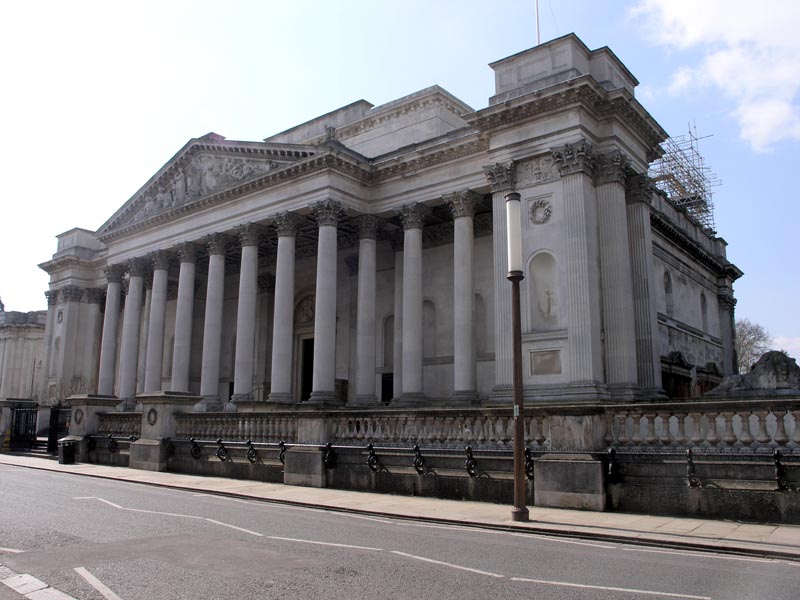 |
| Richardson Candle on Trumpington Street outside The Fitzwilliam Museum |
|
Some of the roads within the city of Cambridge are lit by tall, tubular fluorescent lanterns. These distinctive
lights are mounted to the sides of buildings in the cramped, narrow, central streets or can be found on bronze
coloured fluted cast iron columns along the wider sections of roadway.
Even given the rich history of Cambridge, and its architectural treasures, visitors will often
comment on these novel examples of street furniture. These lanterns have their own unique story and hark back to a more
civically enlightened time where the streetscape was important, and civic pride often necessitated the design of bespoke
lighting units for a city.
Cambridge is the last city in the UK to retain its own custom-designed lighting stock from
the post-war period. Furthermore these street lights were designed by one of the eminent architects of the time.
The Richardson Candles (as they are known) have stood in the centre of the city of Cambridge for over fifty years.
But their time is now limited and Cambridge’s Richardson Candles will soon be removed, thus heralding the end of
a chapter of street lighting history.
|
civic pride
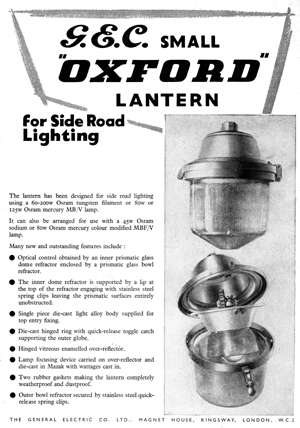
|
The GEC designed an entire new optical system for lanterns originally
installed in the City of Oxford. These remained in their catalogues until the late
1960s. Reproductions of these lanterns can still be found in Oxford's
city centre.
|
|
At the start of the 20th century, many electrical company’s lighting catalogues were groaning under
the weight of lanterns and lighting systems named after towns and cities. Manufacturers would produce ranges of lanterns, all
with similar optical systems for identical bulb types, but produced in a wide variety of different styles and decorations,
designed by the local authorities who originally commissioned them.
Gas lanterns could be purchased as either Windsor or Rochesters; early electric lanterns included designs
named after coastal towns (Brighton, Worthing), important industrial centres (Birmingham, Peterborough) and even boroughs of London.
(Additionally any lantern designed for the City Of London, all invariably called the “City” lantern, had to incorporate the city’s seal).
This practise continued throughout the early part of the century, being interrupted by the Second World War,
and resumed briefly during the immediate post-war rebuilding effort.
|
the festival
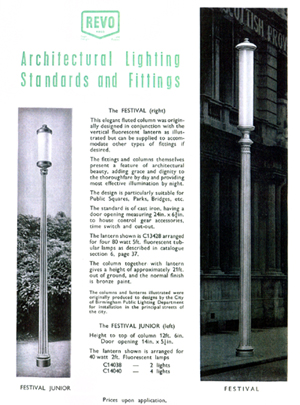
|
An advert for the Festival Lantern from a REVO catalogue dating from the
mid 1950s.
|
|
After the war, the councillors of the city of Birmingham selected the REVO Electric Company of Tipton
to help design and supply columns, brackets and lanterns for the relighting of the city. Part of this commission
included the design of main road lighting for the city, to be installed in 1951 as part of the celebratory
Festival of Britain.
Birmingham’s engineers designed a surprisingly traditional lantern (given the futuristic
nature of the Festival) with a classically fluted column, heavily scalloped and decorated spigot mounting,
all supporting a long tubular opal diffuser. Internally, the lighting technology was modern for the
early 1950s, using four vertically mounted fluorescent tubes. (The fluorescent tube was developed during
the war and was only starting to make an impression on the UK’s street lighting scene).
The views of lighting engineers were mixed on the use of this optical system for road
lighting. This type of lantern lacked any suitable light control, simply depending on the opal tube to diffuse
the light from the four fluorescent tubes. This resulted in the vast majority of the light being cast outwards
from the lantern. Some argued that such a lighting system was seriously inefficient with little light being cast
onto the road surface where it was needed. Others pointed out how this system effectively lit its environments
and in a built-up and narrow enclosure, the space would be adequately lit by reflection. (This was essentially
an early version of washing walls with light and implementing an indirect lighting system).
REVO felt the lantern had universal appeal and added it to their "architectural lighting" catalogue,
emphasising its "grace and dignity" and suitability for "public squares", "parks", "bridges" etc. Given its
connection with the Festival of Britain, it was sold as the "Festival" lantern.
|
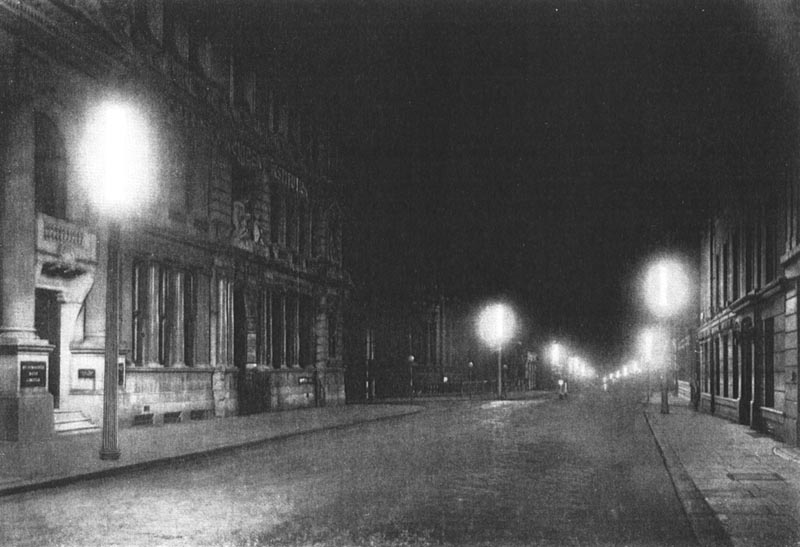 |
| Colmore Row, Birmingham illuminated by the REVO Festival lantern |
the cambridge trial
|
For the first half of the twentieth century, Cambridge’s lighting was predominantly based on gas. The city’s
lighting engineer continued doggedly maintaining the installation after the war, but by the mid 1950s the price of gas had rendered
it inefficient, and the city was looking towards an electric solution to replace its ageing pre-war stock.
A trail scheme was announced with selected manufacturing companies invited to exhibit columns,
brackets and lanterns in-situ along King’s Parade and around the Market Square. It isn’t difficult to imagine
the horror of the local’s as massive, municipal streetlights were erected through the medieval city streets,
towering over the small gas lights then installed.
British Thomson-Houston (of Rugby) and the REVO Electric Company (of Tipon) were selected for the scheme.
BTH were a no-nonsense engineering company and erected their perfectly engineered, but somewhat dominating, lanterns along
Kings Parade. REVO were far more sympathetic to Cambridge’s unique architectural surroundings and placed examples from their
"architectural lighting" range around the market square. This included a lone REVO Festival lantern outside Great St. Mary’s church.
The trial wasn’t a success. Many of the lighting units exhibited were totally unsuited to Cambridge’s streets. Rather than
admit defeat and pick a standard design from these examples, or to have another trial with different manufacturers, the City Surveyor
approached the Royal Fine Art commission for help.
|
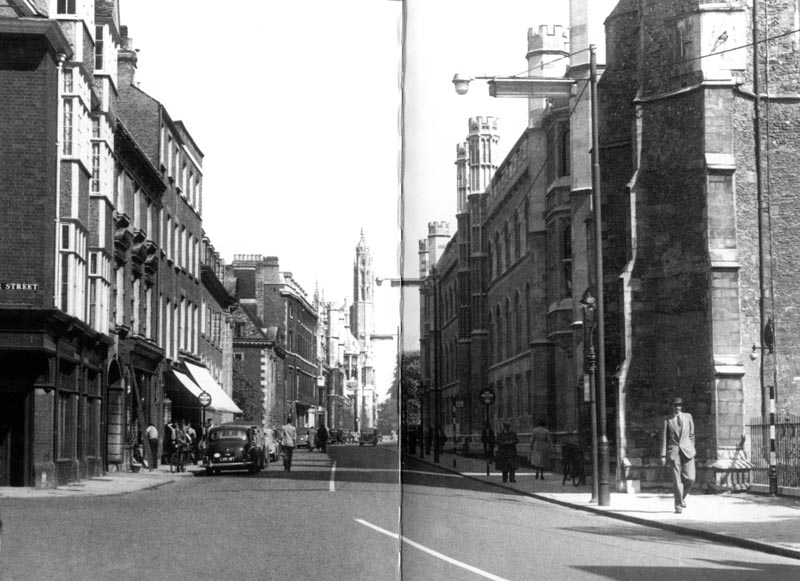 |
The trial lighting scheme of 1955 along King's Parade. This half of the street featured fluorescent and
high-pressure mercury vapour lanterns by BTH. Note the temporary wire strung between each of the lanterns and the tiny gas
lantern still in-situ next to the nearest lamp. |
architect designed solutions
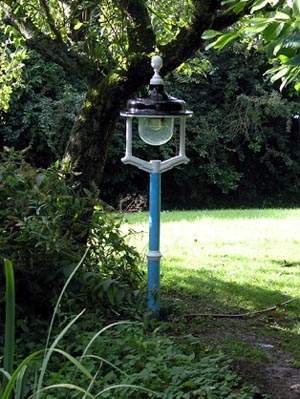
|
An original REVO small Grey Wornum painted in the original Westminster livery. Author's collection.
|
|
Bespoke lanterns were often designed by representatives of the council, the lighting engineer and the firm
who would be mass producing it. The employment of an architect, or specialist designer, was virtually unknown. But when noted
architect Grey Wornum was given the task of redesigning Parliament Square in the early 1950s, his brief included the design
of a special lantern exclusive to Westminster. His traditional, elegant lantern and column were a contemporary twist on
the existing gas lanterns still in use around Westminster. These units were duly manufactured by the REVO Electric Company, and
proved so successful that the lantern was adopted for many of the streets throughout Westminster.
This success wouldn’t have gone unnoticed by the Royal Fine Art Commission. They were originally the arbiters of "good taste" in
street lighting design, and were called upon to judge and "pass" designs. They would’ve been certainly familiar with Wornum’s success, and were able to advise Cambridge City Council when
approached, for advice after the unsuccessful trial in Cambridge.
They were also able to suggest a very surprising, yet inspired choice of designer. Sir Albert Richardson was an
architect of national repute, the president of the Royal Academy and loathed modern street lighting. "Don’t call them street lights, call them monstrosities"
he roared when one of his particular hates, a concrete street lighting column, was installed outside his home in Ampthill in 1957.
That same year, he was approached to design the street lighting for Cambridge.
|
sir albert richardson
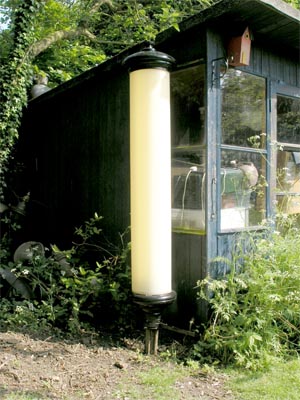
|
An original REVO Festival lantern painted in the City Of York's black colour scheme. This was one of
eight which used to light the approach to York Minster. Author's collection.
|
|
It isn’t known if Sir Albert saw the rejected REVO Festival standing forlornly outside Great St. Marys, but it became
his starting point. It was the most "traditional" lantern, approximating the old post-top lamp posts of yesterday, with classical
underpinnings which would’ve appealed to Richardson. In an interview with "Everybody’s Weekly" in 1957 which pictured the 77 year
old architect shaking his umbrella at a particularly loathsome example, he also sketched his ideal solution: post-top mounted Georgian
style lanterns on slim fluted columns. The REVO Festival was the only street light even approximating that idea.
But Richardson was not just using a traditional approach. The architecture of many of the city’s imposing buildings,
including King’s College Chapel, had strong perpendicular lines and the Festival’s linear silhouette fitted in. Richardson emphasised
this by smoothing the original fussy lines, modifying the column and lantern’s profile so they blended into one to produce a straighter,
less embellished lamp standard. He took his cues from the surroundings itself as he stated during a speech in Cambridge in 1957: “The
lighting in a city should be regulated by the city itself, by the condition and formation of the streets, by the buildings and houses,
and certainly with regard for vistas and silhouettes.”
REVO were duly commissioned to produce the Richardson Candle. Like the Grey Wornum lantern, this street light was
only for one local authority, and only 120 were produced. It never appeared in their catalogue (although the Festival remained relatively popular)
and was unique to the City Of Cambridge.
|
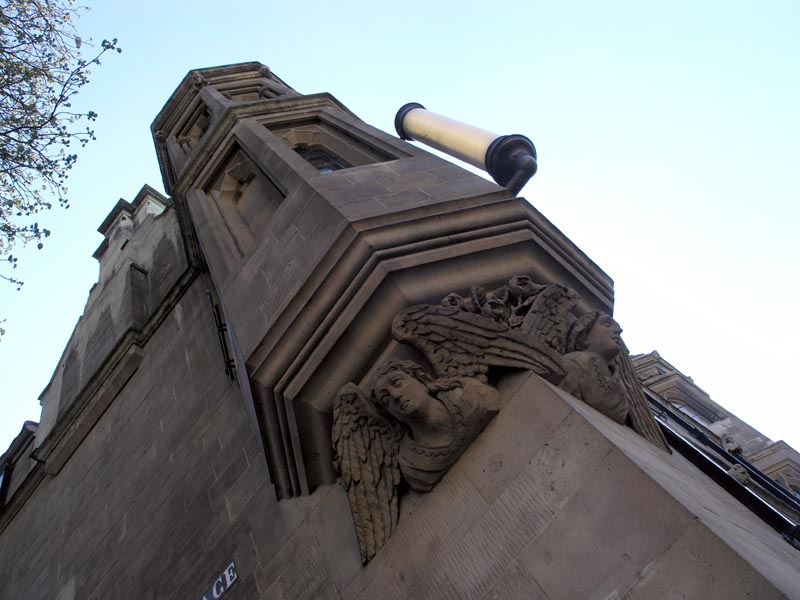 |
Wall mounted Richardson Candle along St. John's Street. |
the richardson candles
|
The "Candle Area" of Cambridge was limited to the historic city core. 56 of the Candles were wall mounted and
installed along the narrow roads of Saint John’s Street, Trinity Street, Silver Street, Market Street, Petty Curry and sections of
Sidney Street. The other 64 Candles were column mounted and could be found along Bridge Street, Sidney Street, the market place,
Peas Hill, Benet Street and Trumpington Street.
They were initially seen as a modern intrusion into an ancient city, towering over the diminutive gas
lamps they replaced. But they were gradually accepted and became one of the city’s talking points.
However, the exclusivity of the design was not without its problems. The column mounted Candles were
venerable to traffic and shattered when accidentally knocked over. As the street light was never massed produced,
Cambridge City Council purchased REVO Festival columns and lanterns as spares; first from the manufacturer, and then
second hand from other authorities. When those sources ran out, a multitude of different types of columns and lanterns
were eventually used as replacements.
The 1970s saw the lighting levels around the market place and Peas Hill improved by the replacement of the
Candles with standard street lighting units. The poor illumination of the Candles was beginning to tell, especially along
the open stretch of Trumpington Street where indirect illumination was not possible. Richardson was an architect, and not a
lighting designer; his error (from a lighting point of view) was to design his street light around daytime appearance and
neglect its ability at lighting the street.
Other authorities had realised their own mistakes with vertical fluorescent post-top lighting and it was gradually
starting to disappear from the nation’s streets. The original installation of REVO Festivals in the City of Birmingham was duly swept away.
|
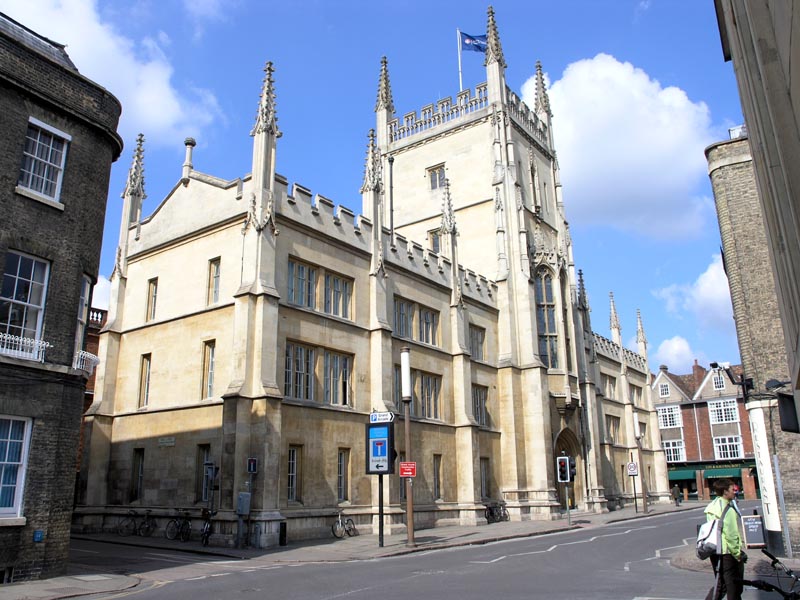 |
The Richardson Candle outside the Cambridge University Press offices on Trumpington Street. |
the energy crisis
|
The energy crisis of the 1970s saw a radical rethink amongst lighting engineers. Many were happy to compromise between
efficiency and aesthetics during the 1950s and 1960s; selecting the less-efficient white-light sources of fluorescent and high-pressure
mercury for residential, retail and civic areas rather than use the highly efficient low-pressure sodium. But with the price of oil, and
therefore electricity, starting to climb, then lighting engineers were forced to rethink these niceties.
Most of Cambridge’s side streets were lit with double tube fluorescent lanterns and the council started the huge task
of replacing them all with low pressure sodium. The remaining Candles themselves came under threat, as the detrunking of the A10
brought the street lights into the County Council’s remit. A move was proposed to replace the inefficient Candles with a more
efficient high-pressure sodium lighting source.
In a documented entitled “Why Snuff the Candles?” the case was made to try and preserve the wall mounted Candles
and increase their efficiency by replacing the ageing fluorescent tubes with multiple high-pressure sodium lighting sources.
Additional experiments by the City Lighting Engineer with various replacement designs on rear of the Guildhall remained inconclusive
and nothing was done for the next several years.
In the late 1980s, half the installation of Candles was swept away by a relighting scheme. From Bridge Street,
down along Sidney Street, Saint Andrews Street and along Market Street and Petty Curry, the Candles were all removed and replaced
by banded sphere lanterns fitted with high pressure sodium. The remaining Candles could now only be found installed Saint
John’s Street, King’s Parade, Silver Street, Benet Street and Trumpington Street.
(Oddly the council did not retain the removed stock and a pile of Richardson Candle columns could be
found at the architectural salvage yard Solopark. This meant that further collisions would result in ever more fragmentation of the original installation with replacements with modern columns).
|
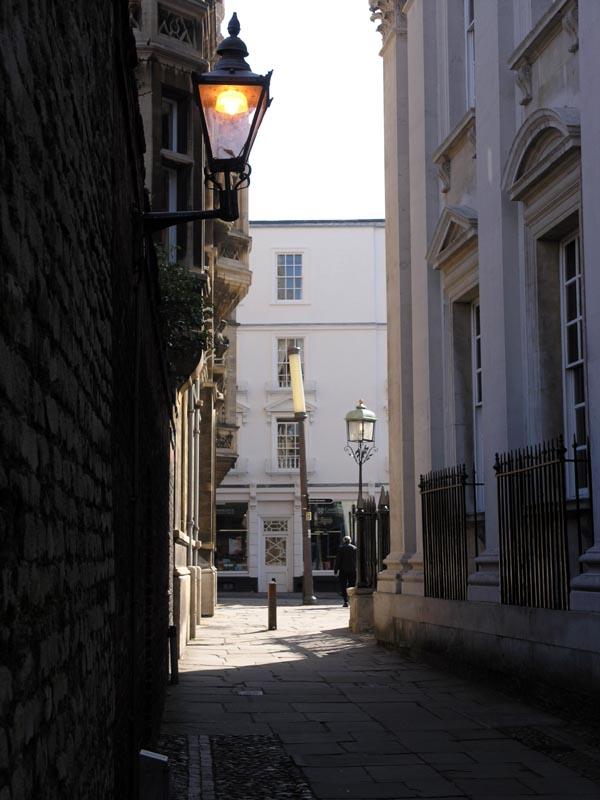 |
Richardson Candle on King's Parade. |
possible replacements
|
By the late 1990s, Cambridge had a reputation of being a "dark city". The remaining Candles were not well
maintained and the Perspex opal diffusers were becoming ever-more frosted as sunlight and UV from the bulbs further clouded
their bowls. Their 1950s wiring, a complex rat’s nest of ancient fluorescent technology, was becoming ever more costly to maintain
in full working order, and many lanterns only burnt a couple of their three or four tubes.
In the late 1990s, Spiers and Major were commissioned to produce a Cambridge Lighting Strategy. They noted the
historical importance of the Candles; and they also noted their lack of light control, poor illumination of the road surface and the
ancient lamps and gear. They recommended the removal of all the Candles and the resiting of several in new areas (around the market square or
along Christ’s Piece) with upgraded optical systems. One of the Candles along Kings Parade was duly upgraded but the results were poor and the
experiment was abandoned.
It wasn’t until almost ten years later that the Candle’s fate was finally decided. The forthcoming Cambridge Street Lighting PFI
would see the replacement of all the city’s old lighting stock and therefore a decision had to be made. A new "needle" shaped prototype lantern
produced by D. W. Windsor, using modern optics and a point light source, was installed along King’s Parade (not far from the original REVO Festival
almost sixty years previously). Comments from councillors and members of the public were varied, with some asking for the retention of upgraded columns.
But the decision was made at a meeting on the 21st April 2008 to replace all the Richardson Candles with the new D. W. Windsor lantern.
|
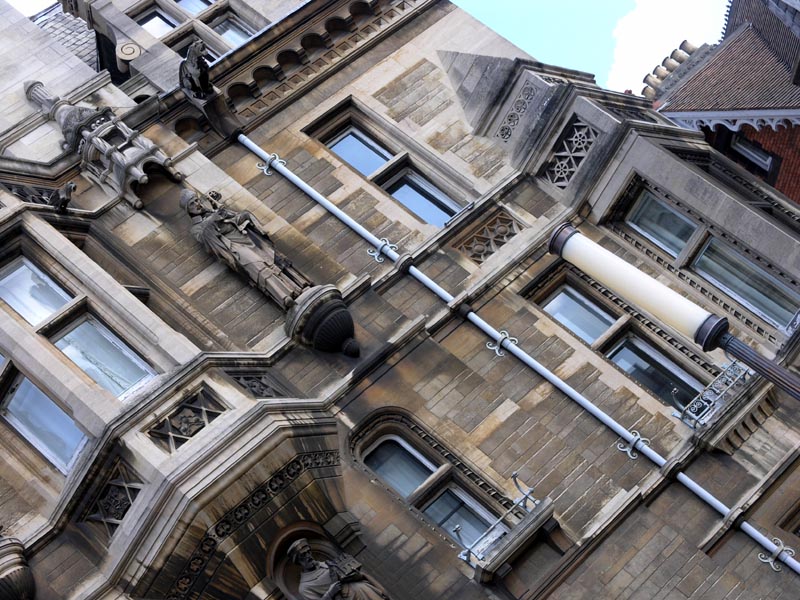 |
The same, slightly twisted, Richardson Candle on King's Parade. |
the end of an era
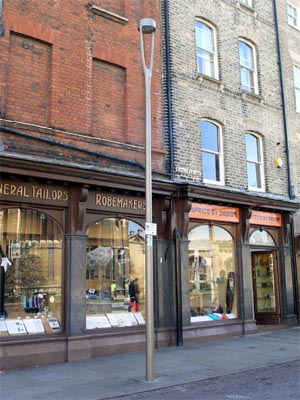
|
The distinctive new street light for the central streets of Cambridge.
|
|
The Richardson Candles have far outlived their original design life, doubling their original twenty-five years planned
longevity. In that time, they have survived numerous schemes for the replacement, and are now the only surviving Group ‘A’ fluorescent public
street lighting system in the UK. But they are also starting to suffer: the ageing electronics are well past their design life, the original
tubes are now in short supply, and some of the tubular diffusers are starting to split and tear.
The connection with Richardson, their unique design particular to Cambridge, and as a relic of a more civic conscious
past should not be overlooked. The only comparable example are the Grey Wornum lanterns of Westminster; there the council have commissioned
bespoke replicas and, although hardly any of the original REVO stock remains, the centre of Westminster is still lit by these iconic lanterns.
It is hoped a similar scheme could be found for Cambridge and some of the Candles retained (as suggested by Spiers and Major).
Modifications to the internal lighting system are required; but modern technologies such as induction lighting or LED suggest a way forward.
As stated in “Why Snuff the Candles”, “they are now accepted and integral part of the street scene. Their reputation is widespread and many architects
and other interested persons visiting Cambridge have remarked on their contribution to the city’s urban form.” It would be a pity to lose them completely.
Simon Cornwell
March 2010
|
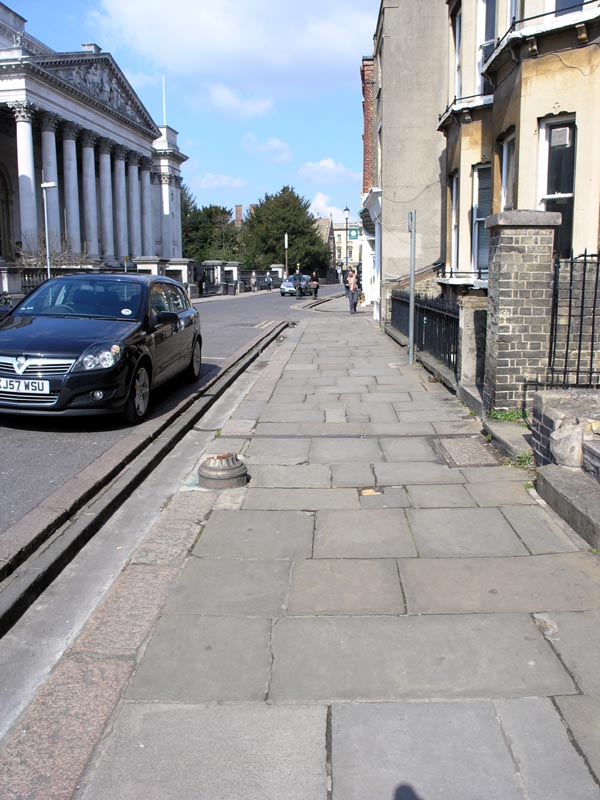 |
The stump of a recent knock-down in Trumpington Street. |
st. john's street
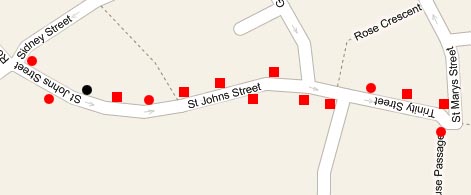
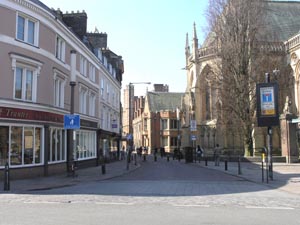
|
As St. John's Street narrows and twists as it travels south, the original lighting engineers chose columns
where they could be accommodated and switched to wall mounted Candles for the
narrowest section of the road.
The survival rate of the Candles has been good although one column was knocked
down outside the School Of Divinity and never replaced. This, and the less-than-optimal performance
of the remaining Candles (which aren't always burning their full compliment of fluorescent
tubes), has given Cambridge the epithet of being a 'dark city'.
|
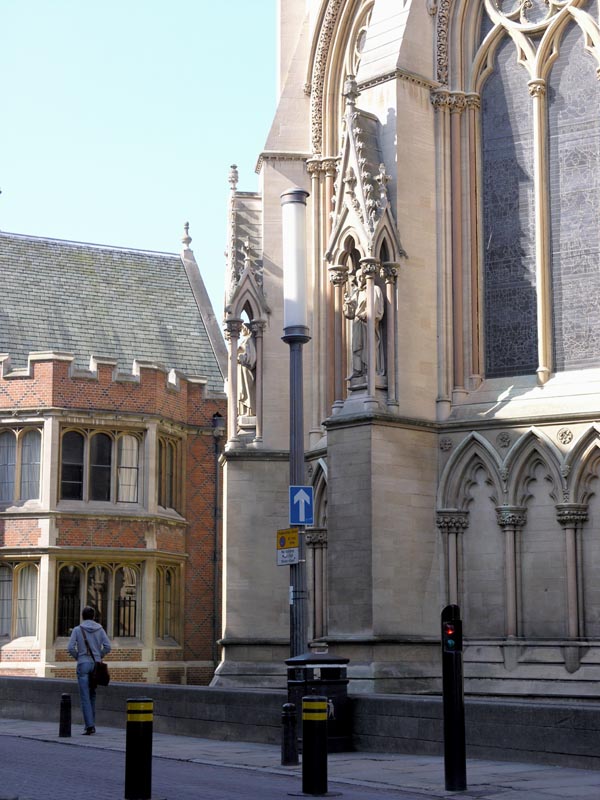
Richardson Candle at the northern entrance of St. John's Street.
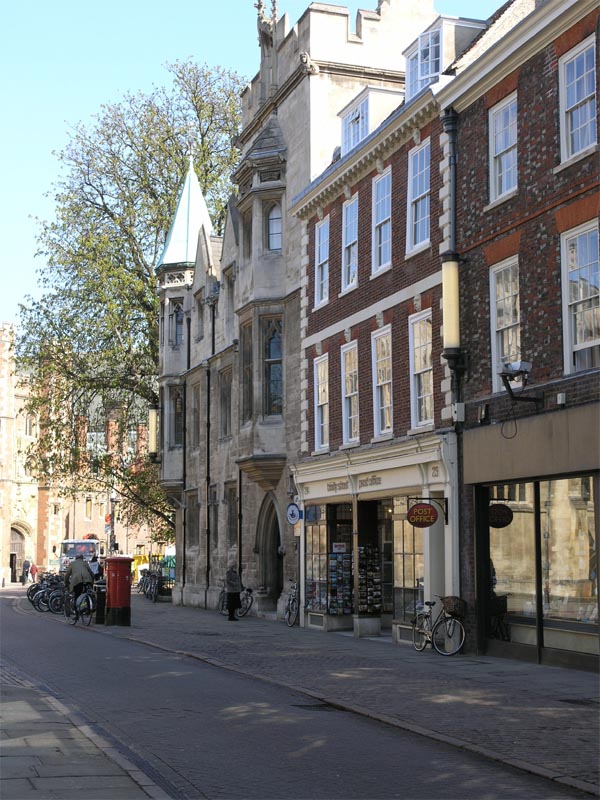
Two wall mounted Candles (which are day-burning).
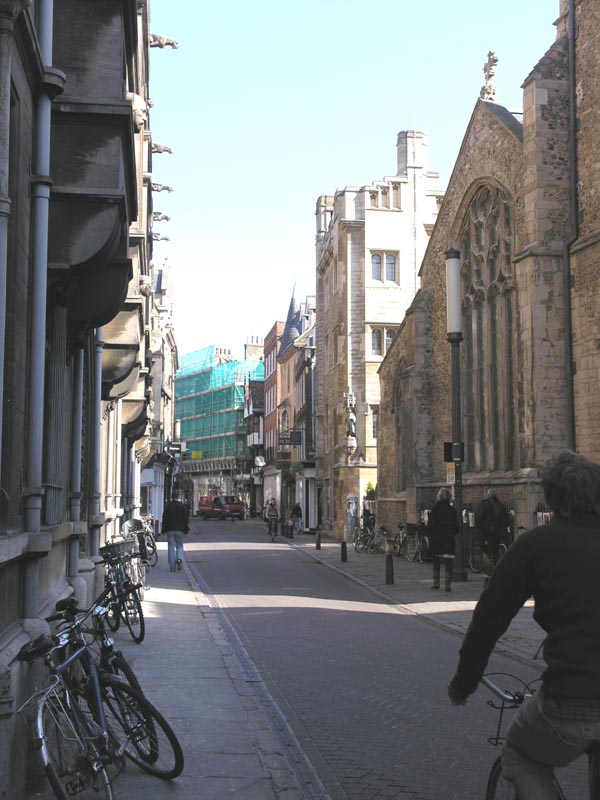
Trinity Street looking northward and showing the mixture of Candle types.
bene't street
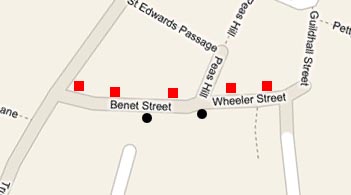
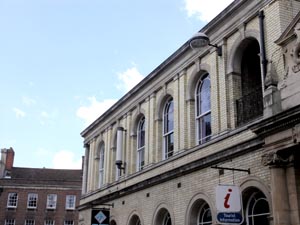
|
Most of Bene't Street and the continuing Wheeler Street was lit by wall mounted Candles with
two post-top versions on the opposite site of the road providing a staggered arrangement.
Both columns have been lost over the intervening years.
As mentioned in Why Snuff The Candles?, Wheeler Street was the trial location for
the 1980s Candle replacements. Therefore it's surprising to see the two wall mounted Candles still
in-situ although they've been supplemented by two Phosco Spheres (this is the
type of lantern which replaced the majority of the Richardson Candles in the replacement
scheme of the late 1980s.)
|
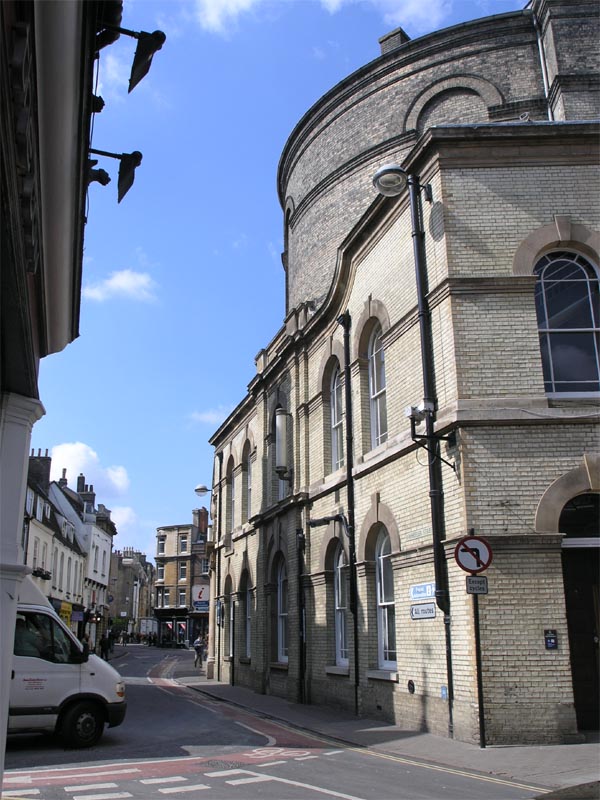
Wheeler Street looking west. Wall mounted Candle surrounded by modern Phosco Sphere supplements.
king's parade / trumpington street
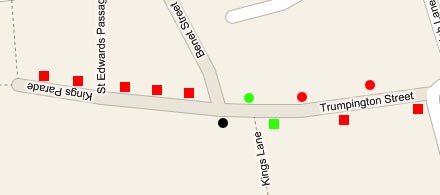
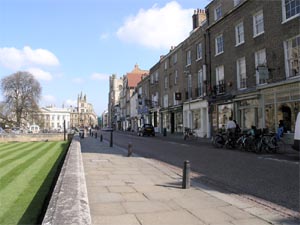
|
Even in the 1950s it would've been unacceptable to place any columns on the western side of Kings Parade (and therefore
interrupting the views of King's College Chapel) so all the Candles along this historic street were mounted on the
buildings.
When the street was repaved in the early 2000s, a row of Philips lanterns on five metre columns were placed along
the road, supplementing the original Candles. They were probably considered temporary as they've never been properly
fixed into the ground.
All five of these wall mounted Candles have survived.
The northern part of Trumpington Street was lit with a staggered arrangement of wall mounted and post mounted Candles. Only one of the
post top Candles has been lost in the intervening years.
The northern end of Trumpington Street also serves as the council's area for trials. A lone wall mounted REVO
Festival lantern appeared in the 1990s (I assume it replaced an existing wall mounted Candle); whilst a post top
Candle was removed and upgraded in accordance with the Speirs And Major Street Lighting Strategy
document. Instead of using four fluorescent tubes, it uses two metal halide bulbs in a specially designed optical system.
|
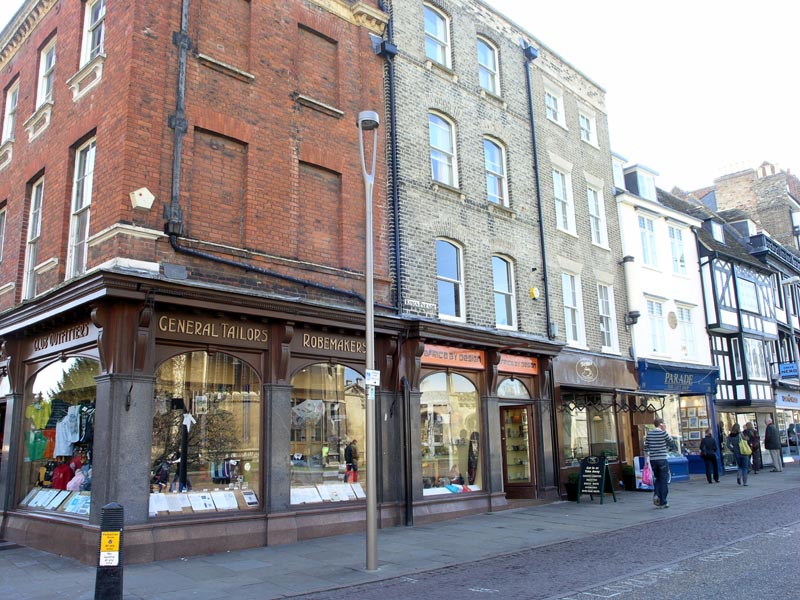
The proposed replacement for the Richardson Candles.
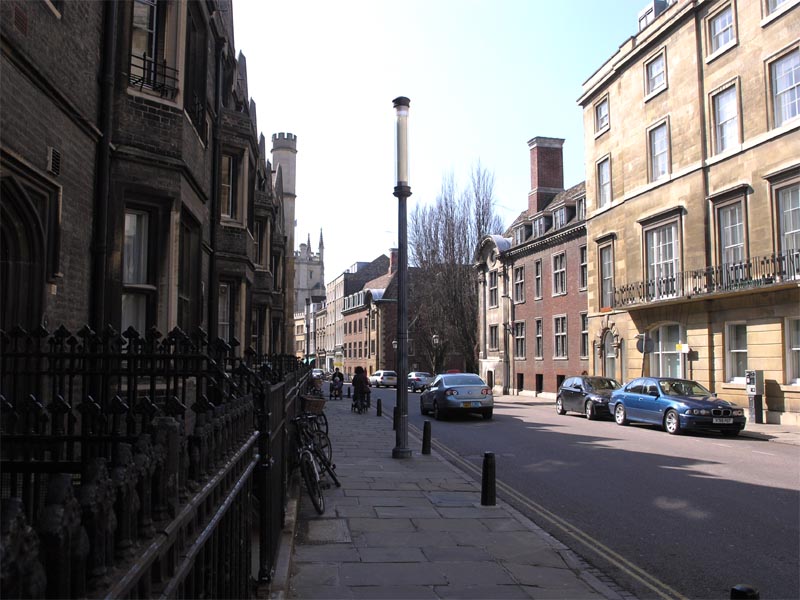
The prototype upgraded lantern. The Festival lantern can be seen as the next lantern along on the right.
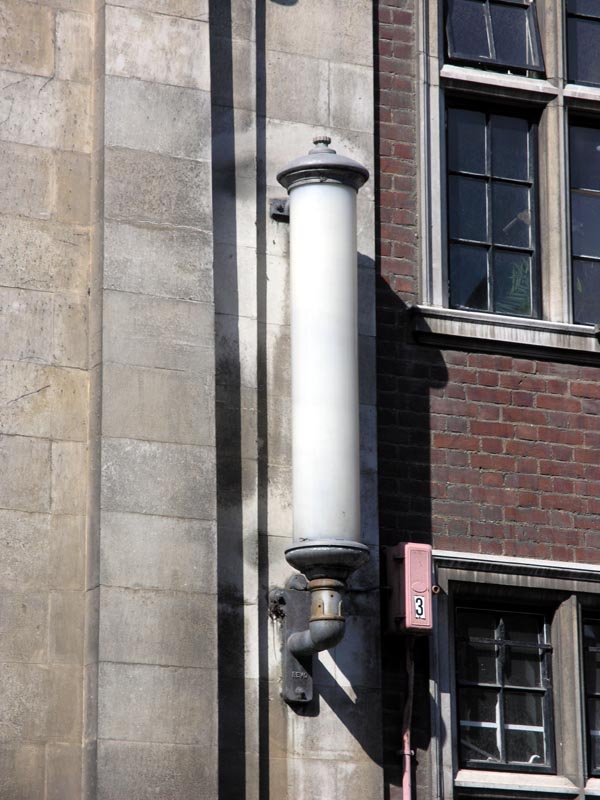
A lone REVO Festival wall mounted lantern.
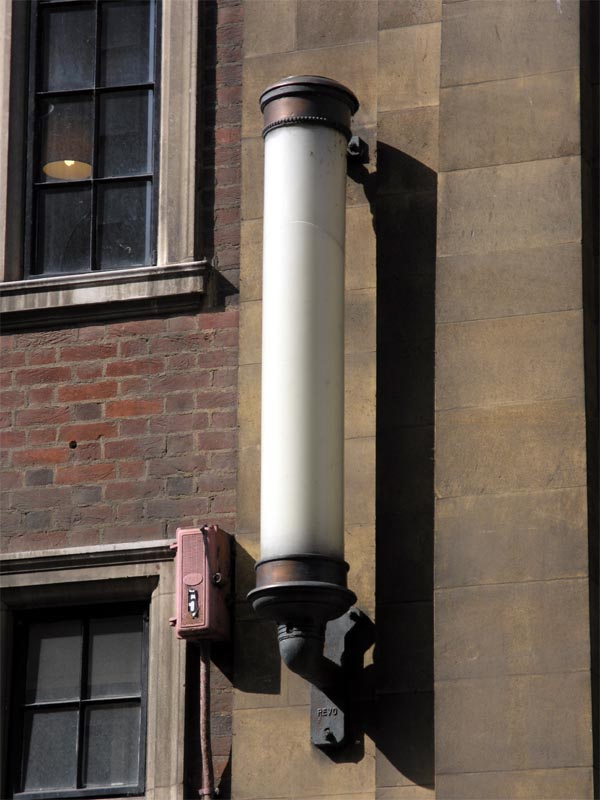
And a wall mounted Richardson Candle (which can be compared with the Festival above). Note that the bowl
has split horizontally.
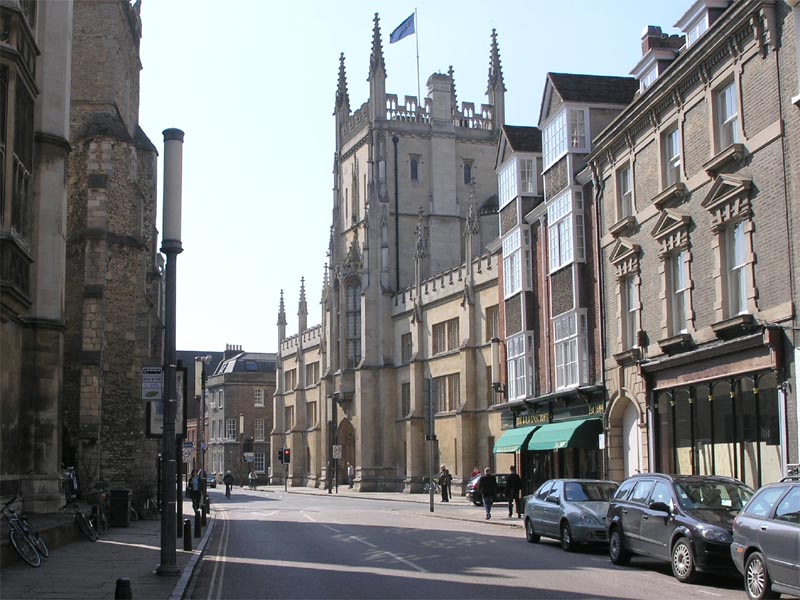
The intersection of Trumpington Street with Silver Street. Five candles can be seen.
silver street
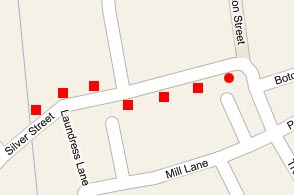
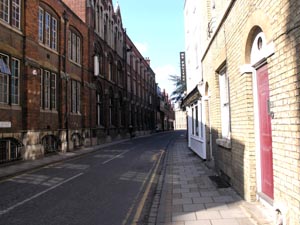
|
Given the narrow nature of the majority of the road, the lighting engineers were forced to
install wall mounted lanterns along most of its length, with just a single column installed
at the road's eastern end.
This has ensured its longevity as the entire 1957 installation is still extant.
The university supplimented the Candles with HPS floodlight units in the mid 1990s.
Therefore the street doesn't appear as 'dark' as the other routes lit by the Candles.
|
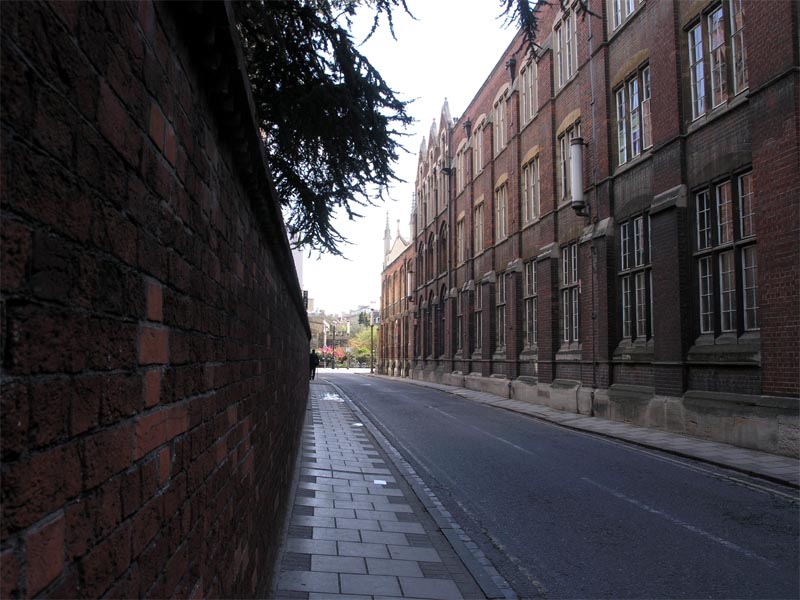
Silver Street eastwards
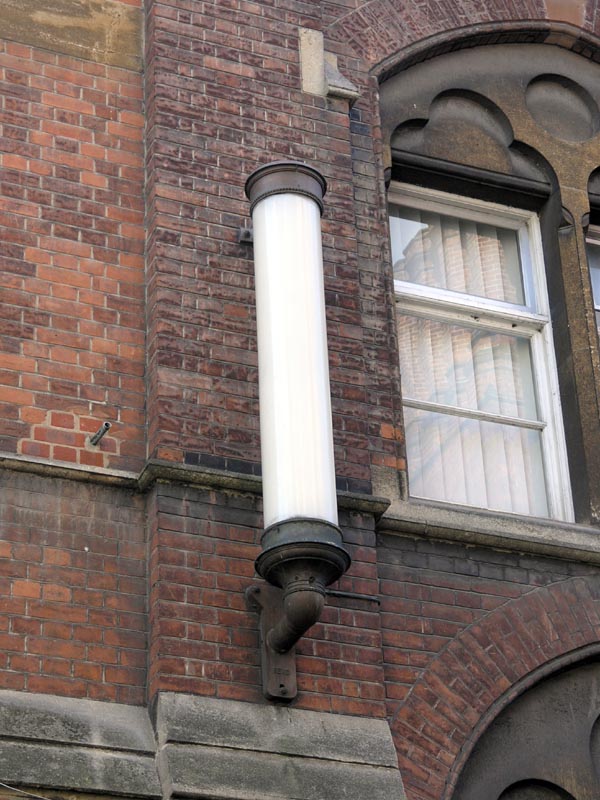
Detail of wall mounted Candle
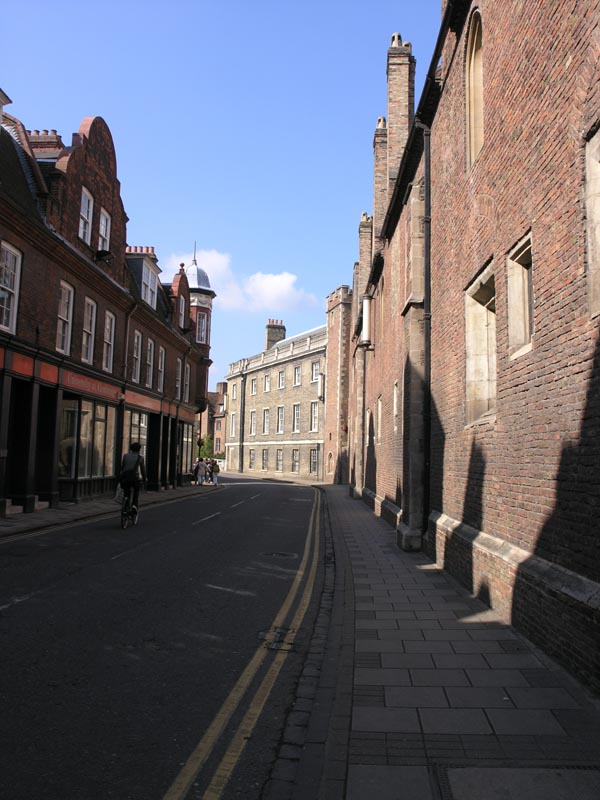
Silver Street view west
trumpington street

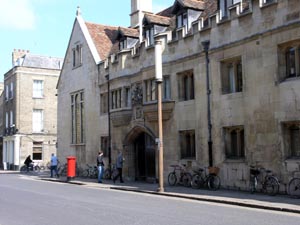
|
As Trumpington Street leaves the centre of Cambridge and widens, the lighting engineer installed post-top
mounted Candles along the entire stretch of the road. At its southern end, the road had widened to such
an extent that pairs of Candles were mounted opposite each other across the road.
Half the original installation has been lost over the years, the majority in the central area of the
road (mostly opposite the Fitzwilliam Museum). The resulting ad-hoc replacements have left the road
with no discernable uniform lighting scheme with a potpourri mix of lanterns, styles and even mounting
heights.
A lone wall mounted lantern can be found at the entrance to Pembroke Street. Its modern replacement
has stood next to it for years, yet the Candle hasn't been removed.
|

The Candles near St. Botolph's Church.
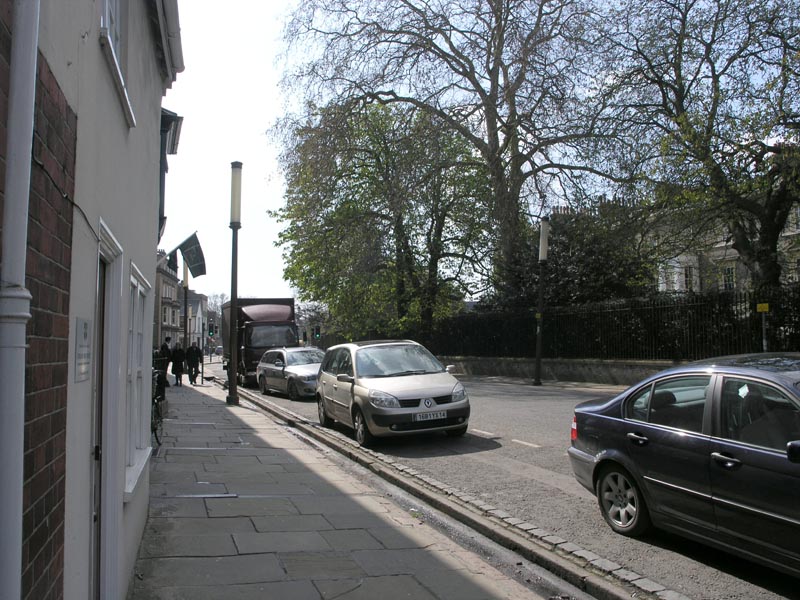
The last Candles mounted opposite each other.
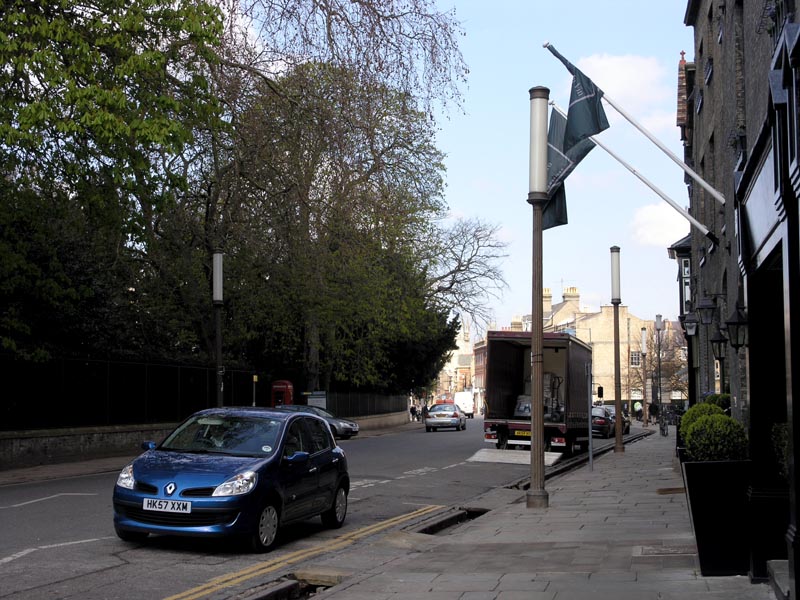
The cluster of remaining Candles at the southern end of the road.
the listing

|
Three years after the decision to replace the Candles was passed, Cambridgeshire and Northamptonshire county councils
announced the successful completion of a joint PFI (Private Finance Initiative) which would see the replacement and modernisation
of all the street lighting in the two counties. The Candles were due to be swept away and replaced by the D.W. Winsdor Sorento,
a striking modern design, which had already been nicknamed "the Needle."
The PFI came on the back of press grumblings
about potential street lighting switch-offs, garbled information about the replacement scheme, and the threat to the Richardson
Candles themselves. Local news programme, BBC Look East, picked up on the story but decided to run a feature solely dedicated to
the Candles. I was interviewed on the 14th April outside Kings College Chapel and the story was broadcast the same day.
Whilst I was keen to emphasize the Candle’s unique story, I also pointed out that they were a poor street lighting solution.
The Sorentos would bring much needed light to Cambridge’s dark city streets, but perhaps a small number of Candles
could be relocated to another public space where they wouldn’t be the sole source of light. In that manner, Richardson’s unique
contribution to the architecture of Cambridge wouldn’t be forgotten, and the Candles would be relieved of having to light
the streets themselves.
So it was a matter of some surprise to discover via the 20th Century Society
that a small number of the Candles had been listed. I don’t know who wrote the application but the list entries (as found on
English Heritage’s website) protect the Candles along St. Johns
and Trinity Street. This is good news for the
preservationists, but presents a headache for the pragmatists; the Candles are poorly maintained, the diffusers are cracking and
splitting (a curse of early 1950s Perspex), and the fluorescent tubes they use are to be made obsolete in 2013. Hopefully these
problems will be solved, so a small number of the original installation can continue to light part of Cambridge’s historic city
streets at night.
Simon Cornwell
May 2011
|
the new problem
The listing of all the Richardson Candles presented the council with a new, albeit unwanted, challenge. Replacements
were ready to be installed as part of the Cambridgeshire-Northamptonshire PFI and the last thing the cash-strapped council
needed was a preservation order slapped on the remaining Candles.
This lead to concerns about the Candle's future. Such views were published in the News And Crier (the local free paper)
on the 17th November 2011.
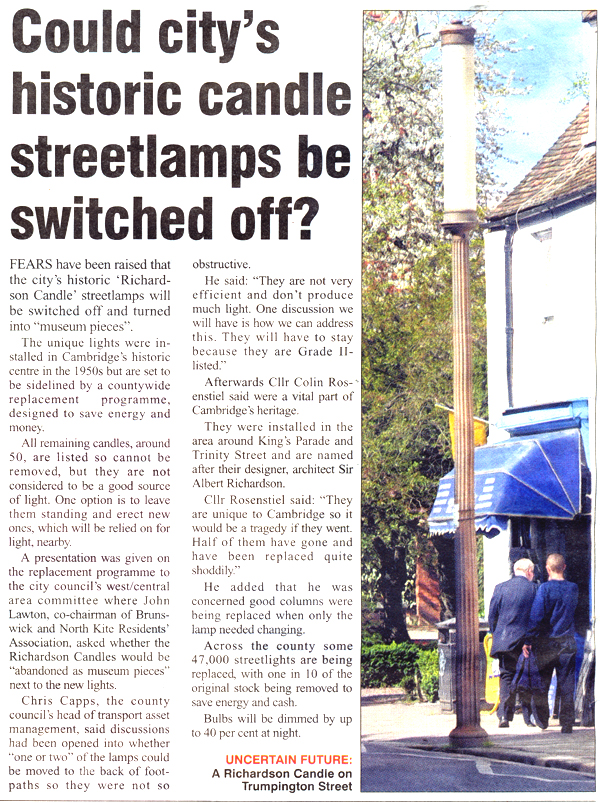
the 2016 refurbishment
As part of the Northampton-Cambridgeshire Street Lighting PFI, the remaining Richardson Candles were refurbished in 2016. In October,
all the lanterns were removed (and replaced with temporary replacement luminaires) for new lamp sources and optical systems to be installed.
the richardson candle in my collection
I recently obtained a wall mounted Richardson Candle for my collection. I believe it was part of the installation
which was removed in the late 1980s.
|



